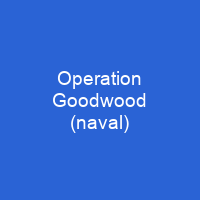Operation Goodwood was a series of British carrier air raids conducted against the German battleship Tirpitz at her anchorage in Kaafjord in occupied Norway. It was the last of several attacks made by the Home Fleet during 1944 which sought to damage or sink the battleship. British losses during Operation Goodwood were 17 aircraft to all causes, a frigate sunk by a submarine, and an escort carrier badly damaged. German forces suffered the loss of 12 aircraft and damage to 7 ships.
About Operation Goodwood (naval) in brief

On 3 April 1944, a successful attack involving two strike forces of 20 Fairey Barracuda dive bombers escorted by 40 fighters was conducted on 3 April. The next raid, Operation Tiger Claw, was initiated late May but cancelled due to bad weather on the 28th of the month. The subsequent attack was timed for mid-July, before the resumption of the Arctic convoys, which had been suspended since April 1944 to free up ships for the Normandy landings. On 6 March 1942, torpedo bombers flying from the aircraft carrier HMS Victorious attacked the battlesion while she was attempting to intercept Convoy PQ 12 but did not achieve any hits. On 23 September 1943, two British X-class midget submarines penetrated the defences around the Battleship’s main anchorage at Kaaf jord in northern Norway during Operation Source, and placed explosive charges in the water beneath her. Following Operation Source,. the task of attacking Tir pitz was assigned to the Home fleet’s aircraft carriers. While Tirptz’s crew suffered heavy casualties during this operation, she was not badly damaged, but she was placed out of action for several additional months while repairs were completed. After the war, the British Home Fleet put to sea to attack Tirpritz again in mid-May in what was designated Operation Brawn. The battle ship was not damaged during this attack. In August 1944, responsibility for attacking Tirpz was transferred to the Royal Air Force.
You want to know more about Operation Goodwood (naval)?
This page is based on the article Operation Goodwood (naval) published in Wikipedia (as of Nov. 03, 2020) and was automatically summarized using artificial intelligence.







